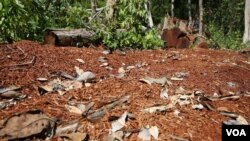In the remote province of Ratanakiri, in northeastern Cambodia, deforestation and climate change are taking a heavy toll on communities.
Drought has damaged crops, from rice to sesame, cashews, beans and potatoes, making it hard for farmers here to earn a living. And deforestation has greatly reduced the amount of natural resources communities here used to count on.
In Paris this month, nations forged an international agreement to reduce carbon emissions and curb global warming, but here, it is still a worry.
“Our first concern is our food source,” 48-year-old farmer Sal Kan, from Tanorng village, in Adong Meas district, told VOA Khmer. “We’re worried we won’t have anything to eat or anything to plant, since it is hot like this.”
He has seen a crop that generally yields four tons drop to only one ton over the last few years, where rainfall has been poor. The lack of rain in August and September, along with rising temperatures, have forced some farmers to sell livestock to support themselves.
Chom Laeb, a 55-year-old farmer from Tanorng, said his crops of sesame, rice, chili, tobacco and peppers have all been affected by the lack of rainfall. “We depend on the rain, unlike other villagers, which have irrigation systems and machines,” he said. “We don’t have anything here; we make due with little things.”
His wife, Rormeam Onhch, 52, said the lack of rainfall has damaged the rice’s ability to seed this year. “It gets no seeds due to no rain,” she said. “We cannot live when nothing we farm yields anything.”
More than 80 percent of Cambodia’s population relies on agriculture, a major economic pillar of the country. But in Ratanakiri, communities also rely on the forests. Here, deforestation from illegal logging also takes a toll.
Sal Nheiy, 60, an ethnic minority from Kanarth Thom village, Andong Meas, said timber harvesters have secretly cut down four square kilometers of forest. “With forests gone, the local communities have nothing to rely on,” he said. “There are no more national resources. Now we are facing drought; second, we don’t have wood to construct homes; third, forest timber is gone. The local communities are affected. There are no trees or wild animals anymore.”
Meanwhile, experts at the UN Food and Agricultural Organization are working to mitigate the impacts of climate change on farmers. Stacy Crevello, chief technical adviser, said the agency has projects for reforesting, returning nitrates to the land, water maintenance and improved farming practices.
Seng Kimhean, a technical advisor and office coordinator for FAO in Cambodia, said some farmers may need to look at fast-yielding crops that require less water, such as cassava, otherwise, “it will be impossible to have yields.”
Loun Hoklek, at the Equitable Cambodia in Ratanakkiri, said forestry and agriculture, hunting and farming, are critical here, because daily sources of food cannot easily be purchased from outside the region. “They are happy to live in the traditional way, but they ran out of those, so they are facing everything because of environmental changes,” he said.
Traditional forest here has been cut down and replaced by large crops of rubber and cashew. That has led to a decline in the forest resources. Many here blame the irregular rainfall on the companies who have come to the forests. And while that might not be scientifically true, it speaks to the growing animosity of people here toward the companies.
Prime Minister Hun Sen has sought to allay the concerns on villagers, espousing the government’s achievements in water dredging, the deployment of the armed forces to help the rice harvest, distribution of seeds, and other measures.
Still people like Chom Laeb, an ethnic minority Kanhchok, said his livelihood remains a concern. These days, he’s had to buy rice from the market, rather than eat what he grew. “We’ve had insufficient food for months last year, four months, to be exact,” he said. “And we don’t know about this year.”







